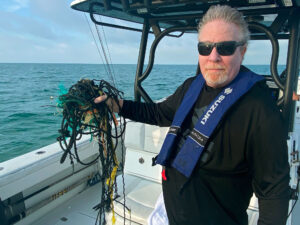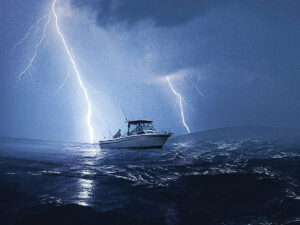****I’ve been negligent: we haven’t talked about chum in a while. Luckily, I’ve discovered a new method of making chum: The next time you dunk your outboard’s lower unit in a bucket so you can start it on land, pour a bunch of baitfish in. Shift it into forward gear, and stand back. If you’re smart, like me, you’ll be sure to shut down the motor if scales and fish goo clog the water intakes. If you’re smarter than me, you might choose to use one of these other alternative chum grinding methods – all of which have been tested by yours truly during those boring-as-hell/can’t-go-fishing winter months.
The Blender. Set it to “chop” and clear skin off of the blades now and again (unplug the blender first – putting mammal blood in your chum violates IGFA rules!).
The Sausage Grinder. It doesn’t work as well as you’d think. If yours has any plastic parts, don’t use it on fish longer than 3″.
AdvertisementThe Food Processor. It works well but skin can cause jams.
The Chainsaw. Don’t even think about it; the first time you hit the throttle fish chunks will go cart-wheeling 30′ through the air.
The Hammer. It works quite well, especially when you need chum on short notice. Smack the fish a few times to crush the meat. Then use a knife to slice open the skin in several places, and insert the fish into a mesh bag. The desecrated body will leak bits and juices, and create a beautiful chum slick.
Advertisement
Tasty Freeze
Guides in alaska deal with supercharged fish like coho salmon every day, so I asked a couple if they knew of any northern exposure fishing tips that applied to fish found in the Lower 48.
Capt. Jim Patchett says to fish frozen fillets rigged so they flutter and spin: Cut fillets into a diamond shape, then run the point of a 3/0 short-shank hook through the skin side, turn it over, and bring it back out the meat side. Drop it down to the bottom, then reel it back up. The off-center hook in the stiff bait causes a great action. Once the fish thaws, switch it out.
Capt. Mike Fenton’s favorite trick is using hollow lead tubing (www.berrysbaits.com) rigged off of a three-way dropper loop. These leads are heavy enough to tick bottom but pull loose when snagged. I placed a 1⁄4″ lead tube on the scale and discovered it weighed just 0.4 ounces An inch of the 3⁄16″ lead was 0.3 ounces. Capt. Mike dresses it out with two fluorescent pink beads pegged above the hook (so it resembles freshly spawned salmon eggs), but in the rest of the country the rig will work best with a Spin-N-Glow rigged in front of a sliding Fluke Killer bucktail, a red Tru-Turn hook tipped with a strip of Fishbites, or a Clouser Deep Minnow. -John Page Williams
| Bow mount, stern mount, motor mount – where’s the best place to put your electric trolling motor, and why? It depends on how and where – bay, lake, or backwater – you fish. To find out which position works best and for whom, I spent a day under different types of electric power with walleye pro staffer Scott Fairbairn. -Jon Meade | ||
| Position: Bow mount Model: Minn Kota Terrove 80 Purpose: Pulling the boat forward, especially against a strong wind. Advantages: Provides great boat control; positioned at the fingertips of an angler casting from the bow; less clutter than a stern mount motor once deployed. Disadvantages: Gets in the way of fly fishers and throwing a cast net; the bow design on some boats won’t accommodate it; in rough seas the prop may ventilate as the boat rises and falls; more cluttered than a stern mount when not deployed. Best Application: Cast-and-retrieve fishing along shorelines, flats, and structure. | Position:Stern mount Model:Minn Kota Vector 3X Purpose: A low-cost power source. Advantages: More affordable than other mount options; easier to reach and use when operating from the rear of the boat; provides maximum control when “sliding” over structure (slowing the drift) stern-to in the wind or current. Disadvantages: Provides less control when running straight ahead; creates more stern clutter and can interfere with outboard operation. Best Application: Back trolling; principal power source on small boats; pinpoint jigging on the drift. | Position: On the outboard’s lower unit Model: Minn Kota EM101 Purpose: To make small speed adjustments when trolling; trolling when an external motor would be unsightly or impractical. Advantages: Uses the boat’s outboard rudder for control; allows slow trolling speeds; stays out of the way. Disadvantages: Draft is full draft of the outboard; doesn’t provide as much forward control as a bow-mount, especially in a head-wind. Best Application: Slow trolling without creating any clutter; the only option for boats not designed as fishboats and unable to accommodate other mounting options. |
Grouper Tip:
“If you’re anchored over a wreck or other hard structure, you can excite grouper by jump-starting the food chain. You’ll need a cannonball-type downrigger weight tied to the end of a heavy rig. Drop the weight and allow it to freefall until it hits. Then raise it 10′ or so and let it freefall again. Repeat the process a dozen times, then bring the cannonball up and drop your baits. Banging on the structure will dislodge and smash all kinds of organisms and sediments, which creates easy pickings for the small fish, which in turn attract the big fish.” -from Rudow’s Guide to Fishing the Mid Atlantic, www.geareduppublications.com. Rigging Tip
Use 20′ of monofilament backing when spooling up with superlines and braids so the line wont spin around once under tension. ****
New Dog, New Tricks
Penn Spinfisher $89.99 • 219/229-9415 • www.pennreels.com
I’ve been fishing with Penn Spinfisher reels since they were green with white drag knobs. Over the decades I’ve found every incarnation of the series to be workhorses. To see if the new Spinfisher SSg lives up to the legacy, I clamped a 550 SSg (holds 275 yards of 12-pound test line and weighs 15 ounces) on a rod, spooled it up, and started casting to stripers.
The new bail design, incorporating a trip friction ramp, never tripped early. The lightweight graphite body didn’t wear me out and the infinite anti-reverse allowed me to set up quickly when the fish hit. While I bested fish to 22 pounds with the SSg, the main shaft isn’t as heavy-duty as on the beefier, more expensive Slammer series. As a workaday spinner that won’t corrode apart, this reel is the ticket.
Get Down Cannon Downrigger $699 • 800/227-6433 • www.cannondownriggers.com
In-line planers aren’t exactly fun to use. Enter the Cannon Mag 10 Tournament Series downrigger, which is equally at home chasing big tarheel kings as it is Great Lakes trout. With a Minn Kota motor under the hatch, this rig retrieves 250′ per minute with 20 pounds of lead on the line, making it the fastest, most powerful unit on the market. IP68 electrical plugs, waterproof toggle switches, and a Lexan body keep water damage at bay, and there’s a line-counting dial. The positive ionic control emits a low positive charge in the water that’s supposed to be pleasant for the fish. But my favorite feature is the automatic short stop. As long as the unit is spooled with wire (the function works on a ground), it will automatically stop retrieving your weight at the water’s surface.









